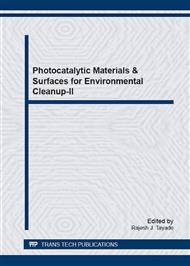p.247
p.273
p.295
p.306
p.317
p.325
p.334
p.349
p.364
Photocatalytic Degradation of Dyes by Al2O3-TiO2 and ZrO2-TiO2 Nanocomposites
Abstract:
Al2O3-TiO2 and ZrO2-TiO2 nanocomposites have been prepared by sol-gel method using polyvinylpyrrolidone-polyethylene glycol (PVP-PEG) as templating agents. While Al2O3 in the former is of end-centered monoclinic crystal structure ZrO2 in the latter is a 4:1 blend of monoclinic and tetragonal phases. In both the composites TiO2 is present as anatase. The energy dispersive X-ray spectra provide the compositions of the composites as Al:Ti::1:12 and Zr:Ti::1:1. Scanning electron micrographs display the sizes of Al2O3-TiO2 and ZrO2-TiO2 particles as 30-77 and 38-57 nm, respectively. The diffuse reflectance spectra of both the composites show band gap excitation in the UV-A region. Both the composites display similar photoluminescence and the observed near band gap emission and deep level emission agree with those of TiO2. The impedance spectral studies reveal that the charge-transfer resistance of ZrO2-TiO2 is less than that of Al2O3-TiO2. Both the composites exhibit photoconductance. The photocatalytic activities of the prepared nanocomposites depend on the dye employed. While both the composites degrade methylene blue and rhodamine B effectively under UV-A light the photodegradation of methyl orange is slow. Rhodamine B degrades on both the nanocomposites under visible light also, which is through dye-sensitized photocatalytic mechanism.
Info:
Periodical:
Pages:
325-333
Citation:
Online since:
December 2012
Authors:
Keywords:
Price:
Сopyright:
© 2013 Trans Tech Publications Ltd. All Rights Reserved
Share:
Citation:


